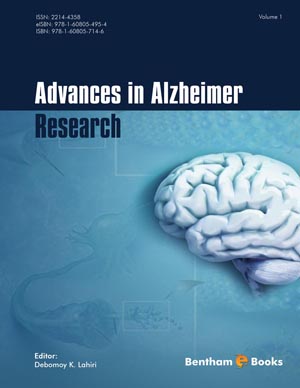Abstract
Accumulation of amyloid β-peptides (Aβ) in the brain is believed to contribute to the development of Alzheimer disease (AD). Aβ, a 40-42 amino acid-comprising proteolytical fragment of the amyloid precursor protein (APP), is released from APP by sequential cleavages via β- and γ-secretases. However, the predominant route of APP processing consists of successive cleavages by α- and γ-secretases. Alpha-secretase attacks APP inside the Aβ sequence, and therefore prevents formation of neurotoxic Aβ. After cleavage by α-secretase, the soluble N-terminal domain of APP, which possesses neurotrophic and neuroprotective properties, is released. In AD patients, a decrease in α-secretase processing of APP has been found and therefore, strategies to improve α-secretase activity are obvious. Several years after descriptive reports on α-secretase, the responsible enzyme(s) have been identified to belong to the family of A Disintegrin And Metalloproteinase (ADAM). Three of these membrane-anchored zinc-dependent metalloproteinases, ADAM10 as well as ADAM17 and perhaps also ADAM9 display α-secretase activity. Since the individual knock-out of these proteinases in neither case completely prevented α-secretase processing of APP, it seems likely that different ADAMs are mutually compensating, and under particular conditions conduct α-secretase cleavage of APP. In addition to ADAMs, perhaps other membrane-associated metalloproteinases contribute to the shedding of APP. Stimulation of α-secretase activity can be achieved via several signaling cascades including phospholipase C, phosphatidylinositol 3-kinase and serine/threonine-specific kinases such as protein kinases C, and mitogen-activated protein kinases. Calcium ions, direct activation of protein kinase C and stimulation of distinct G protein-coupled receptors, receptor tyrosine kinases and ligand-regulated ion channels are known to increase α-secretase processing of APP. Serotonin uptake inhibitors and ion channel agonists are in clinical trials to test their efficiency in the treatment of AD.
Keywords: Alzheimer´s disease, neuroprotection, neurodegeneration, amyloid, non-amyloidogenic, amyloid precursor protein, alpha-secretase, beta-sectrtase, BACE, G protein-coupled receptor, ion channel, calcium signaling, protein kinase C, mitogen-activated protein kinase, ADAM, disintegrin metalloproteinase, matrix metalloproteinase, blood-brain barrier, RAGE, LRP.






















